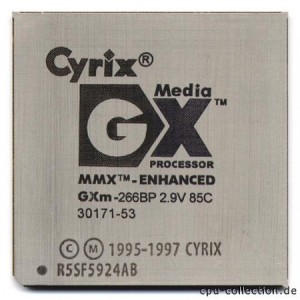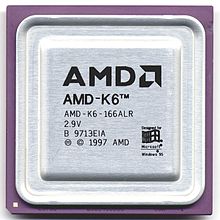A detailed history of the processor
Cyrix 6×86 Series (1995)
Cyrix, by this time, was a major player in the alternative processor market. They had been around since 1992, with their release of the 486SLC. By 1995, they had their own 5×86 processor and it was considered the only real competition to the AMD counterpart. But, they released their 6×86 in 1995. It was designed to go head to head with Intel’s Pentium processor. Dubbed “M1”, the chip contained two super-pipelined integer units, an on-die FPU, and 16 KB of write-back cache. It used many of the same techniques internally as the Intel and AMD chips to increase performance. Like AMD beginning with their K5 (see below), Cyrix used the P-rating system. It came in PR-120, 133, 150, 166 and 200 versions. Each rating had a “+” after it, indicating that it performed better than the corresponding Pentium. But, did it?
Cyrix had had a reputation for lagging in the area of performance, and the M1 was not an exception. The chip used a weaker FPU than both AMD and Intel, meaning it could not keep up with the competition in areas such as 3D gaming or other math-intensive software. On top of that, the chip had a reputation for running hot. Users had to get CPU fans that could keep these hot processors cool enough to run stably. Cyrix tried to combat this issue with the 6x86L processor. This “low power” processor made use of a split voltage (3.3 volts for I/O and 2.8 volts internally).
MediaGX (1996)
MediaGX was Cyrix’s answer to low-cost entry level PC’s. Making use of a standard x86 processor core, the chip lowered the cost of PCs using it by integrating many of the common PC components into the chip itself. MediaGX had integrated audio and video circuitry, as well as circuitry to handle many of the common tasks normally handled by chips on the motherboard itself. The CPU spoke directly to a PCI bus and DRAM memory, and the video was rather high-quality SVGA (for the time). It could support up to 128 MB of EDO RAM in 4 separate memory banks, and the video sub-system could support resolutions of up to 1280x1024x8 or 1024x768x16.
The integration of MediaGX was actually spanned across two chips: the processor itself and the MediaGX Cx5510. The chip requires a specially designed motherboard. It is not Socket 7 compatible. As a result, it is really an outsider in relation to the other processors we were discussing, but being that it was on the timetrack of history for CPUs, it bears mentioning.
AMD K5 (1996)
While AMD was competing with Intel with their 5×86 processor, this chip was not a true Pentium alternative. In 1996, however, AMD released the K5. This chip was designed to go head to head with the Pentium processor. It was designed to fit right into Socket 7 motherboards, allowing users to drop K5’s into the motherboards they might have already had. The chip was fully compatible with all x86 software. In order to rate the speed of the chips, AMD devised the P-rating system (or PR rating). This number identified the speed as compared to the true Intel Pentium equivalent. K5’s ran from 75 MHz to 166 MHz (in P-ratings, that is). They contained 24KB of L1 cache and 4.3 million transistors. While the K5’s were nice little chips for what they were, AMD quickly moved on with their release of K6.
Pentium MMX (1997)
Intel released many different flavors of the Pentium processor. One of the more improved flavors was the Pentium MMX, released in 1997. It was a move by Intel to improve the original Pentium and make it better serve the needs in the multimedia and performance department. One of the key enhancements, and where it gets its name from, is the MMX instruction set. The MMX instructions were an extension off the normal instruction set. The 57 additional streamlined instructions helped the processor perform certain key tasks in a streamlined fashion, allowing it to do some tasks with one instruction that it would have taken more regular instructions to do. It paid off, too. The Pentium MMX performed up to 10-20% faster with standard software, and higher with software optimized for the MMX instructions. Many multimedia applications and games that took advantage of MMX performed better, had higher frame rates, etc.
MMX was not the only improvement on the Pentium MMX. The dual 8K caches of the Pentium were doubled to 16 KB each. It also had improved dynamic branch prediction, a pipelined FPU, and an additional instruction pipe to allow faster instruction processing. With these and other improvements, the Pentium line of processor was extended even longer. The line lasted up until recently, and went up to 233 MHz. While new PCs with this processor are all but non-existent, there are many older PCs still using this processor and going strong.
AMD K6 (1997)
The K6 gave AMD a real leg up in performance, and it virtually closed the gap between Intel and AMD in terms of Intel being perceived as the real performance processor. The K6 processor compared, performance-wise, to the new Intel Pentium II’s, but the K6 was still Socket 7 meaning it was still a Pentium alternative. The K6 took on the MMX instruction set developed by Intel, allowing it to go head to head with Pentium MMX. Based on the RISC86 microarchitecture, the K6 contained seven parallel execution engines and two-level branch prediction. It contained 64KB of L1 cache (32KB for data and 32KB for instructions). It made use of SMM power management, leading to mobile version of this chip hitting the market. During its life span, it was released in 166MHz to 300 MHz versions. It gave the early Pentium II’s a run for their money, but AMD had to improve on it in order to keep up with Intel for long.
Cyrix 6x86MX (1997)
Well, Intel came up with MMX and AMD was already using it starting with the K6. So, Cyrix had to get in on the game as well. The 6x86MX, also dubbed “M2”, was Cyrix’s answer. This processor took on the MMX instruction set, as well as took an increased 64KB cache and an increase in speed. The first M2’s were 150 MHz chips, or a P-rating of PR166 (Yes, M2’s also used the P-rating system). The fastest ones operated at 333 MHz, or PR-466.
M2 was the last processor released by Cyrix as a stand-alone company. In 1999, Via Technologies acquired the Cyrix line from it’s parent company, National Semiconductor. At the same time, Via also acquired the Centaur processor division from IDT.
Click here: Next Page























30 thoughts on “A detailed history of the processor”
In fact, the 8080 external interface was distinctly different from the 8086, in idea, not just width – for example, 8080 pin 21 (DMA acknowledge).
The 8086 was (almost) binary compatible with the 8080 for “regular programs” ie: not ones that twiddled ports nor relied on specific interrupt/trap behaviour.
So where do you draw the line? Where does Bob draw it? WHere does Fiona draw it? All in different places, I suspect.
The author obviously chose to draw their line at the 8086, probably because delving back beyond the original IBM PC machines might not be worthwhile given a presumed intended audience…
In fact, the 8080 external interface was distinctly different from the 8086, in idea, not just width – for example, 8080 pin 21 (DMA acknowledge).
The 8086 was (almost) binary compatible with the 8080 for “regular programs” ie: not ones that twiddled ports nor relied on specific interrupt/trap behaviour.
So where do you draw the line? Where does Bob draw it? WHere does Fiona draw it? All in different places, I suspect.
The author obviously chose to draw their line at the 8086, probably because delving back beyond the original IBM PC machines might not be worthwhile given a presumed intended audience…
In fact, the 8080 external interface was distinctly different from the 8086, in idea, not just width – for example, 8080 pin 21 (DMA acknowledge).
The 8086 was (almost) binary compatible with the 8080 for “regular programs” ie: not ones that twiddled ports nor relied on specific interrupt/trap behaviour.
So where do you draw the line? Where does Bob draw it? WHere does Fiona draw it? All in different places, I suspect.
The author obviously chose to draw their line at the 8086, probably because delving back beyond the original IBM PC machines might not be worthwhile given a presumed intended audience…
“The following chips are considered the dinosaurs of the computer world. PC’s based on these processors are the kind that usually sit around in the garage or warehouse collecting dust. They are not of much use anymore, but us geeks don’t like throwing them out because they still work. You know who you are.”
sounds just like my tech teacher becouse he is always complaining about how things have changed and shows us pictures from back when computers still used tapes and how he used to get paid to change the tapes every two hours for a hospitle
“The following chips are considered the dinosaurs of the computer world. PC’s based on these processors are the kind that usually sit around in the garage or warehouse collecting dust. They are not of much use anymore, but us geeks don’t like throwing them out because they still work. You know who you are.”
sounds just like my tech teacher becouse he is always complaining about how things have changed and shows us pictures from back when computers still used tapes and how he used to get paid to change the tapes every two hours for a hospitle
“The following chips are considered the dinosaurs of the computer world. PC’s based on these processors are the kind that usually sit around in the garage or warehouse collecting dust. They are not of much use anymore, but us geeks don’t like throwing them out because they still work. You know who you are.”
sounds just like my tech teacher becouse he is always complaining about how things have changed and shows us pictures from back when computers still used tapes and how he used to get paid to change the tapes every two hours for a hospitle